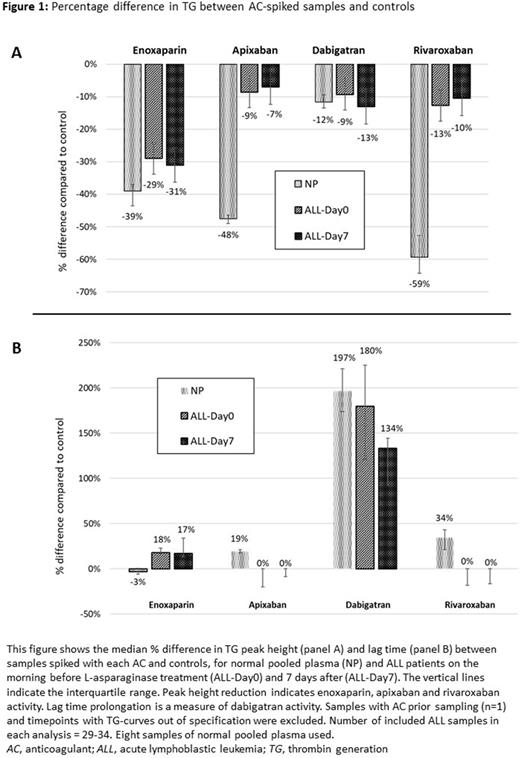Abstract
Background: Venous thromboembolism (VTE) is a frequent complication in patients with acute lymphoblastic leukemia (ALL). Low molecular weight heparin (LMWH) reduces the risk of VTE in ALL, but is not well tolerated in children. VTE rates remain unacceptably high in adults despite LMWH prophylaxis. Thus, novel strategies for VTE prevention are warranted. In the primary analysis of the PREVAPIX-ALL trial there was no statistically significant reduction in VTE among children treated with the oral factor Xa inhibitor, apixaban, compared to no anticoagulation (AC). Comparative data on activity of different anticoagulants are needed to guide planning of VTE prophylaxis trials.
Aims: To characterize and compare the ex-vivo effect of LMWH (enoxaparin), oral direct factor Xa inhibitors (apixaban, rivaroxaban) and oral direct thrombin inhibitor (dabigatran etexilate) in ALL patients' samples using thrombin generation (TG).
Methods: A prospective observational cohort study of 46 children with newly-diagnosed ALL, treated with the L-asparaginase (ASP)-based BFM protocol, at a tertiary medical center. Patients on therapeutic-dose AC at baseline were excluded. Blood samples were drawn before ASP treatment (ALL-Day0) and 7 days after (ALL-Day7). Normal pooled plasma (NP) was collected from healthy adult volunteers. Samples were spiked ex-vivo with enoxaparin [0.2 U/mL], apixaban [39 ng/mL], rivaroxaban [39 ng/mL] and dabigatran [150 ng/mL] or vehicle (i.e., control). AC concentrations chosen based on 50% peak reduction (for Xa inhibitors) or 200% LT prolongation (for dabigatran) in NP. Subsequently, TG was performed initiated using 5 pM tissue factor in the presence of 4 µM phospholipids using Calibrated Automated Thrombogram method in these samples. Results are expressed as peak height (PH) and lag time (LT) and relative reduction or prolongation (% difference in PH or LT, respectively) in plasma samples spiked with anticoagulants compared to control. Reduction in PH reflects enoxaparin, apixaban and rivaroxaban activity, while LT prolongation indicates dabigatran activity. This report focuses on measures reflecting the activity of each drug. Descriptive statistics were used to show the median [interquartile range (IQR)] for continuous variables and percentages for categorical data. T-Test / Mann-Whitney U test and paired T-test / Wilcoxon test used to compare between paired and non-paired samples, respectively.
Results: Selected sample characteristics are as follows: median age, 7.75 years [IQR 3.73-11.93]; 19 (41%) females; median BMI, 16.8 [IQR 15.5-19.9]; B-cell precursor immunophenotype in 33 (71.7%) and T-cell in 13 (28.3%); prior VTE in 1 (2%). Median PH [IQR] in control samples (without AC) was 256.6 [252.6-265.3] nmol/l, 396.0 [347.2-464.7] nmol/l and 354.4 [307.1-407.4] nmol/l in NP, ALL-Day0 and ALL-Day7 respectively. Median LT [IQR] in control samples was 2.7 [2.5-2.83] nmol/l, 1.8 [1.7-2.3] nmol/l and 1.7 [1.6-2] nmol/l in NP, ALL-Day0 and ALL-Day7 respectively.
Median % differences in PH and LT between samples spiked with different anticoagulants and controls are shown in Figure 1A and Figure 1B, respectively. Enoxaparin, apixaban and rivaroxaban reduced PH in NP, ALL-Day0 and ALL-Day7 samples (p<0.0005). There was less reduction in PH with enoxaparin, apixaban and rivaroxaban in ALL-Day0 samples than in NP (p=0.029, p<0.0005, p<0.0005 respectively), suggesting reduced anticoagulant activity in ALL patients compared to subjects without ALL.
LT was prolonged with dabigatran in NP, ALL-Day0 and ALL-Day7 samples (p<0.05). Dabigatran resulted in a similar LT prolongation in ALL-Day0 and NP (p=0.677), suggesting a preserved AC effect in ALL. There was less LT prolongation in ALL-Day7 (134% [123-175%] than in ALL-Day0 (180% [134-238]; p=0.031). This reflects an ongoing dabigatran effect after ASP, albeit to a lesser degree.
Conclusions: Our ex-vivo results suggest limited anticoagulant activity of enoxaparin and lack of anticoagulant activity of apixaban and rivaroxaban (both factor Xa inhibitors) in preventing VTE in ALL, in line with prior clinical data. In contrast, dabigatran etexilate, an oral direct thrombin inhibitor not previously tested in ALL, exhibited preserved anticoagulant activity in ALL patients, even after exposure to ASP. This may suggest that dabigatran should be investigated in clinical studies for the unmet need of VTE prophylaxis in ALL.
Disclosures
Leader:Luzsana: Membership on an entity's Board of Directors or advisory committees; Novartis: Consultancy, Membership on an entity's Board of Directors or advisory committees, Other: Lectures; Leo Pharma: Other: Lectures; Sanofi: Other: Scientific lectures; Bayer: Membership on an entity's Board of Directors or advisory committees, Other: Lectures; Pfizer: Consultancy, Membership on an entity's Board of Directors or advisory committees, Other: Lectures. Gavrieli:Novartis: Current Employment. Moshe:Novartis: Membership on an entity's Board of Directors or advisory committees, Other: lectures; Astellas: Membership on an entity's Board of Directors or advisory committees, Other: lectures; Abbvie: Consultancy, Honoraria, Membership on an entity's Board of Directors or advisory committees, Other: lectures. Raanani:Pfizer: Consultancy, Honoraria, Membership on an entity's Board of Directors or advisory committees, Research Funding, Speakers Bureau; Janssen: Speakers Bureau; BMS: Consultancy; Novartis: Consultancy, Research Funding. Wolach:Novartis: Consultancy, Membership on an entity's Board of Directors or advisory committees; Astellas: Consultancy, Membership on an entity's Board of Directors or advisory committees; Jansen: Consultancy, Membership on an entity's Board of Directors or advisory committees; BMS: Consultancy, Membership on an entity's Board of Directors or advisory committees; Neopharm: Consultancy, Membership on an entity's Board of Directors or advisory committees; Amgen: Research Funding; AbbVie: Consultancy, Membership on an entity's Board of Directors or advisory committees, Research Funding.
Author notes
Asterisk with author names denotes non-ASH members.


